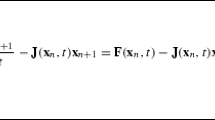Abstract.
An efficient new method for the exact digital simulation of time-invariant linear systems is presented. Such systems are frequently encountered as models for neuronal systems, or as submodules of such systems. The matrix exponential is used to construct a matrix iteration, which propagates the dynamic state of the system step by step on a regular time grid. A large and general class of dynamic inputs to the system, including trains of δ-pulses, can be incorporated into the exact simulation scheme. An extension of the proposed scheme presents an attractive alternative for the approximate simulation of networks of integrate-and-fire neurons with linear sub-threshold integration and non-linear spike generation. The performance of the proposed method is analyzed in comparison with a number of multi-purpose solvers. In simulations of integrate-and-fire neurons, Exact Integration systematically generates the smallest error with respect to both sub-threshold dynamics and spike timing. For the simulation of systems where precise spike timing is important, this results in a practical advantage in particular at moderate integration step sizes.
Similar content being viewed by others
Author information
Authors and Affiliations
Additional information
Received: 3 October 1998 / Accepted in revised form: 19 March 1999
Rights and permissions
About this article
Cite this article
Rotter, S., Diesmann, M. Exact digital simulation of time-invariant linear systems with applications to neuronal modeling. Biol Cybern 81, 381–402 (1999). https://doi.org/10.1007/s004220050570
Issue Date:
DOI: https://doi.org/10.1007/s004220050570




